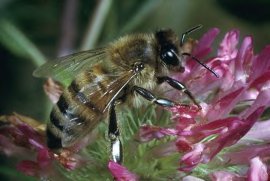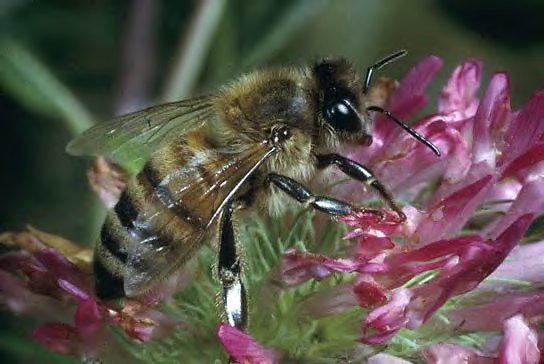Bees, Wasps, and Kin
Description
Male drone 5/8" (15-17 mm); queen 3/4" (18-20 mm); sterile female worker 3/8-5/8" (10-15 mm). Drone more robust with largest compound eyes; queen elongate with smallest compound eyes and larger abdomen; worker smallest. All mostly reddish brown and black with paler, usually orange-yellow rings on abdomen. Head, antennae, legs almost black with short, pale erect hair densest on thorax, least on abdomen. Wings translucent. Pollen basket on hind tibia.
![]()
Warning
The honey bee stings but is not aggressive. CAUTION: Some people are alergic to bee and wasp stings and you should consult with your physician when stung. Aggressive Africanized Honey Bees ("killer bees") have been moving northward in North America and are much more dangerous than the domestic variety.
Food
Adult drinks nectar and eats honey. Larva feeds on honey and royal jelly, a white paste secreted by workers.
Life Cycle: Complex social behavior centers on maintaining the queen for a full lifespan, usually 2 or 3 years, sometimes up to 5. The queen lays eggs at intervals, producing a colony of 60,000-80,000 workers, which collect, produce, and distribute honey and maintain hive. Workers feed royal jelly to queen continuously and to all larvae for first 3 days; then only queen larvae continue eating royal jelly while other larvae are fed bee bread, a mixture of honey and pollen. By passing food mixed with saliva to one another, members of hive have chemical bond. New queens are produced in late spring and early summer; the old queen then departs with a swarm of workers to found new colony . About a day later the first new queen emerges, kills other new queens, and sets out for a few days of orientation flights. In 3-16 days the queen again leaves hive to mate, sometimes mating with several drones before returning to hive. Drones die after mating; unmated drones are denied food and die.
Habitat
Hives in hollow trees and hives kept by beekeepers. Workers visit flowers of many kinds in meadows, open woods, and gardens. Check out the honey bee migration on the "Honey Bee Migration" page.
Range
Worldwide.
Discussion
Settlers brought the Honey Bee to North America in the 17th century. Today these bees are used to pollinate crops and produce honey. They are frequently seen swarming around tree limbs. Honey Bees are distinguished from bumble bees and bees in other families mostly by wing venation.


